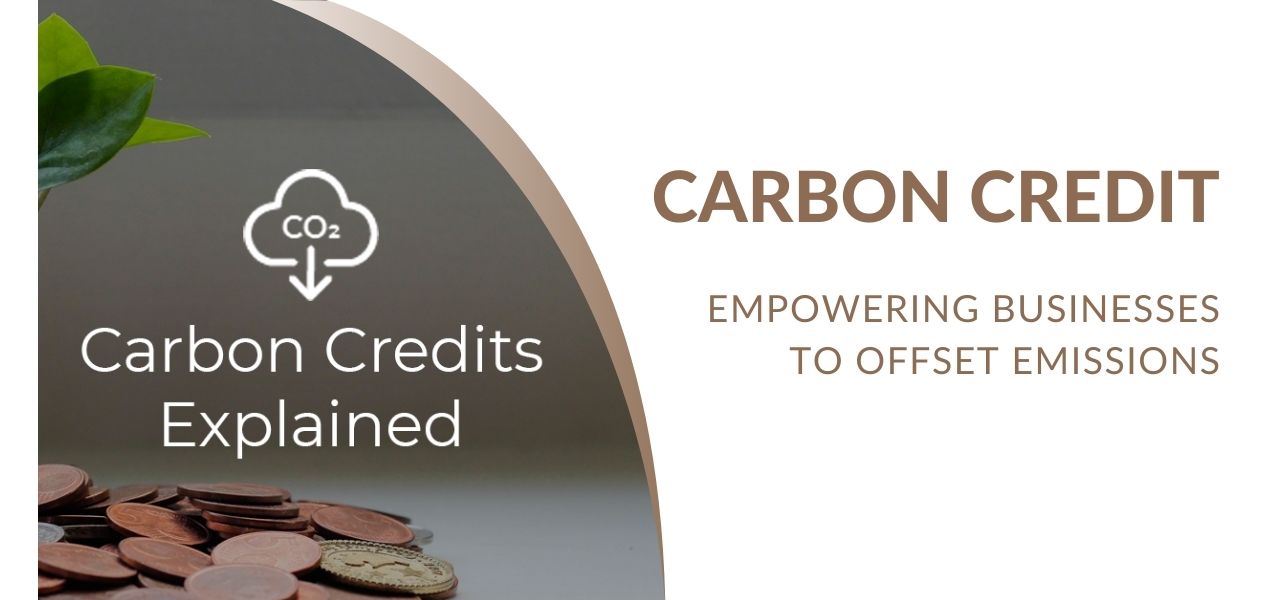Carbon Credit: Empowering Businesses to Offset Emissions

In today's rapidly changing world, businesses are increasingly recognizing the urgent need to reduce their carbon footprint and take responsibility for their environmental impact. Carbon credit has emerged as a powerful tool in this endeavor, enabling businesses to offset their emissions by investing in sustainable projects.
This blog explores the concept of carbon credit, its significance in the fight against climate change, and how it empowers businesses to make a positive difference. Discover the benefits and implementation strategies of businesses leveraging carbon credit to achieve sustainability goals. Join us on this journey towards a greener and more sustainable future.
Understanding Carbon Credit
Carbon credit is a mechanism that enables businesses and individuals to take proactive steps towards mitigating their carbon emissions and combating climate change. By understanding how carbon credit works and the benefits it offers, businesses can make informed decisions and contribute to a more sustainable future.
Carbon credit is based on the concept of carbon offsetting, which involves investing in projects that reduce or remove greenhouse gas emissions. These projects are often located in sectors such as renewable energy, reforestation, and energy efficiency. When a business or individual invests in such projects, they receive carbon credits equivalent to the amount of emissions reduced or removed by the project.
The mechanism behind carbon credit is the notion of a carbon market, where companies or individuals can buy and sell carbon credits. Each credit represents one ton of carbon dioxide or its equivalent greenhouse gas emissions. This creates a market-driven incentive for businesses to reduce their emissions or invest in carbon offset projects.
The significance of carbon credit lies in its potential to drive the transition towards a low-carbon economy. By financially supporting projects that reduce emissions or remove carbon from the atmosphere, carbon credit initiatives help to mitigate the environmental impact of human activities. These projects can range from renewable energy installations to reforestation efforts, from energy efficiency programs to carbon capture and storage technologies.
There are various successful examples of negative carbon initiatives and projects. One notable example is the REDD+ program (Reducing Emissions from Deforestation and Forest Degradation) which aims to protect forests and prevent carbon emissions from deforestation. Another example is the development of direct air capture (DAC) technologies that can capture carbon dioxide directly from the air, offering a pathway towards negative emissions.

By promoting the implementation of carbon credit systems and supporting innovative projects, society can make significant progress in combatting climate change. Carbon credit enables a shift towards sustainable practices, encourages investment in green technologies, and fosters the development of projects that actively remove carbon from the atmosphere.
The Benefits of Carbon Credit for Businesses
Carbon credit programs offer numerous advantages for businesses looking to offset their emissions and contribute to a more sustainable future. By participating in carbon credit initiatives, businesses can not only reduce their environmental impact but also reap several benefits for their reputation, brand, and compliance with regulations and market requirements.
Environmental Advantages of Offsetting Emissions:
Implementing carbon credit programs allows businesses to take responsibility for their carbon footprint and actively contribute to the reduction of greenhouse gas emissions. By investing in verified carbon offset projects, such as renewable energy installations or reforestation efforts, businesses can effectively neutralize their own emissions. This leads to a positive environmental impact by helping to mitigate climate change, preserve natural resources, and protect biodiversity.
Reputation and Brand Enhancement through Carbon Neutrality:
Being associated with carbon neutrality can significantly enhance a business's reputation and brand image. Customers, investors, and stakeholders increasingly value companies that demonstrate a commitment to sustainability and environmental responsibility. By offsetting their emissions through carbon credit programs, businesses can showcase their dedication to mitigating climate change and differentiating themselves as responsible corporate citizens.
Compliance with Regulations and Market Requirements:
In many regions, governments have introduced regulations and policies to limit carbon emissions and promote sustainable practices. By participating in carbon credit programs, businesses can meet regulatory requirements and demonstrate compliance with environmental standards.

Additionally, an increasing number of consumers are demanding transparency and accountability when it comes to a company's environmental impact. Adopting carbon credit initiatives helps businesses meet market demands and stay ahead of evolving consumer preferences.
In conclusion, the benefits of carbon credit for businesses are substantial. Beyond the environmental advantages of offsetting emissions, participating in carbon credit programs offers opportunities for reputation and brand enhancement through carbon neutrality. By embracing carbon credit, businesses can not only contribute to a healthier planet but also position themselves as responsible leaders in their industry.
Implementing Carbon Credit Strategies
To effectively offset their emissions and contribute to a more sustainable future, businesses need to implement carbon credit strategies. This involves several key steps that help them assess, measure, and mitigate their carbon footprint. Here are some essential elements to consider when implementing carbon credit strategies:
Assessing and measuring carbon emissions
The first step is to understand the carbon emissions associated with the business operations. This involves conducting a comprehensive carbon footprint assessment, which identifies the sources and quantities of greenhouse gas emissions. By quantifying their carbon footprint, businesses can set clear goals for emission reduction and determine the appropriate carbon credits needed for offsetting.
Identifying suitable carbon offset projects: After assessing their emissions, businesses can identify suitable carbon offset projects. These projects aim to reduce or remove carbon dioxide from the atmosphere, effectively offsetting the emissions generated by the business. Examples of carbon offset projects include reforestation initiatives, renewable energy projects, and methane capture programs.
It is important to choose projects that align with the business's values and have credible third-party verification.
Partnering with credible carbon credit providers
To ensure the effectiveness and integrity of their carbon credit initiatives, businesses should partner with credible carbon credit providers. These providers facilitate the purchase and retirement of carbon credits on behalf of businesses. It is crucial to select providers that adhere to internationally recognized standards and have a transparent and auditable process for verifying and issuing carbon credits.
As part of their carbon credit strategies, businesses can incorporate innovative solutions like plant-based plastic. Companies like AirX produce this carbon negative material using by-products such as coffee grounds, offering an eco-friendly alternative to fossil-based plastic.

By integrating plant-based plastic into their operations, businesses can reduce carbon emissions throughout the entire supply chain. This not only helps them reduce their reliance on fossil fuels but also contributes to building a more sustainable and circular economy. Embracing plant-based plastic as a carbon credit initiative showcases their commitment to environmental stewardship and supports the global effort to combat climate change.
Implementing effective carbon credit strategies requires a holistic approach, involving thorough assessment, careful project selection, and trusted partnerships. By taking these steps, businesses can make significant strides in reducing their carbon footprint and promoting environmental sustainability. Additionally, by adopting sustainable materials like plant-based plastic, businesses can further enhance their carbon credit initiatives and demonstrate their commitment to a greener future.
>>> Learn more: Driving Change with Carbon Negative Products
Contact us
AirX is the world's first carbon-negative bio-material made from coffee grounds manufacturer.
We specialize in producing bio-based composites using recycled carbohydrates derived from by-products such as coffee grounds, coconut husk, husk, and bamboo. Our goal is to promote sustainability through the use of eco-friendly materials.
We are always here to help and provide the best service possible. If you have any questions or would like to receive advice and feedback directly from our sales staff, please do not hesitate to contact us. You can reach us through:
- Whatsapp: +84 969 742 950
- Email: [email protected]
We look forward to hearing from you!

